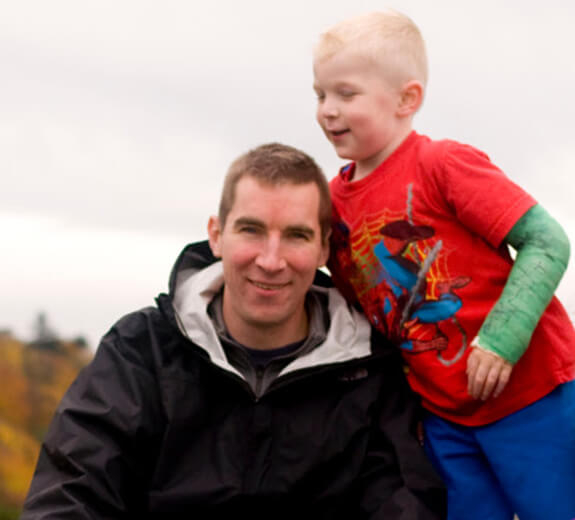Thatcher Heldring is a freelance writer and author focused on type 1 diabetes, environmental education, and other issues related to children and health. He has partnered with clients working on literacy, sustainable communities, youth leadership development, and health policy. He is also the author of four sports novels for young readers and the father of an 11-year-old T1 and a 14-year-old T3. You can reach Thatcher through his website at www.spitballinc.com.

Tips for talking about Type 1 Diabetes
Knowing Just Enough
My son Peter was diagnosed with Type 1 diabetes just before his third birthday. At the time, he was in the stretch run of potty training. Incentivised with M&M’s, Peter was using the toilet more and more frequently. He was also insatiably thirsty. In those days, we knew just enough about diabetes to fear the unspoken truth. But knowing is not accepting.
So we made up our own story. Our son is so bright, he knows that if he drinks more, he will pee more. And if he pees more on the toilet, he will get more M&Ms. It was equal parts denial and bewilderment. Just two busy, confused parents on the verge of a life-altering diagnosis.
When the news came, we were blindsided and dizzy with questions. Does he have Type 1 or Type 2? Are they the same thing? Will he outgrow it? How do we take care of him? Will he be able to play sports? Can he ever eat an M&M again? It was terrifying.
Finding our new normal was not easy. But the terror gradually ebbed, replaced over time by competence, and then confidence, although never stability. Type 1 diabetes does not really get better or worse and the only thing predictable about it is that no two days are ever the same. Through all this uncertainty, we have discovered a few truths about this devious disease.
#1: Type 1 Diabetes and Type 2 Diabetes are very different
Type 2 diabetes is much more common. It is frequently associated with diet, exercise, and other lifestyle factors that cannot always be reduced to poor choices. It can be hereditary and typically occurs in adults, though incidence among children is increasing. Type 2 diabetics still produce insulin, just not reliably, and do not generally live with the same risks of low-blood sugars as Type 1 diabetics.
Type 1 diabetes is an autoimmune disease. For reasons that are not well understood, the immune system attacks the pancreas, shutting it down entirely, leaving the body unable to regulate blood sugar levels, and exposing people like Peter to both short-term and long-term risks. Over a lifetime, uncontrolled blood sugars are hard on the body, causing nerve damage to eyes and limbs and impacting the heart and kidneys. In every hour of any day, low blood sugars can cause seizures, comas, or in some cases, death. There are no breaks or remissions and it cannot be managed without insulin. It is a 24/7 condition.
#2: Nobody gets Type 1 Diabetes from eating too many M&M’s
Ever. And, kids with Type 1 diabetes can eat M&M’s or anything else. They just need the right amount of insulin to help them convert the sugar into energy.
#3 Type 1 Diabetes is Everyday and Constant
There is a reason Seattle Children’s Hospital puts newly diagnosed families through three days of in-house boot camp. Caregivers need to be drilled on dosing, nutrition, carb counting, sick days, technology, and emotional wellness. Type 1 diabetes is constant, absolute, and unforgiving. Peter will never outgrow it. The disease impacts every aspect of daily life.
#4 Kids Will Ask Questions
Kids without Type 1 diabetes are full of questions. For example, what’s that big band aid on his arm? Answer: That’s an insulin pod that gives him medicine he needs to stay healthy. Or, why are you poking his finger? Answer: We do that so we know how much medicine to give him. And don’t ever apologize for asking questions. We love the natural curiosity. But, telling us about your great aunt who lost a limb to diabetes? That’s upsetting.
#5 Type 1 Diabetes Isn’t a Barrier
Kids with Type 1 diabetes go to school. They play sports, just like Jordan Morris, the Seattle Sounders star with Type 1 diabetes. And they love playdates. In fact, please don’t be afraid to have a child with Type 1 diabetes over to your house. They’re just regular kids who want to hang out. Many of them can manage their own blood sugar levels for a few hours and their parents will probably be a text away, maybe parked on your street.
Gratitude
So, that’s how Type 1 diabetes goes. It happens very fast, then everything slows down. You take a hit, and you punch back. You make mistakes, and you learn. You keep going to birthday parties, you go to school, and you make room for gratitude.
We are grateful to brilliant minds at work on better treatments and a cure. To our school nurses who make it possible for Peter to learn, and to feel like a normal kid. To our T1 tribe, our lifeline to sanity and hope. To all of them we say, thank you. And to Peter, we say, you do not need to be a hero. You just need to be you. And we offer him an M&M. Because in a world turned sideways, one thing is certain. That kid has earned it.
Immuno-what? Hear the latest from BRI
Keep up to date on our latest research, new clinical trials and exciting publications.



